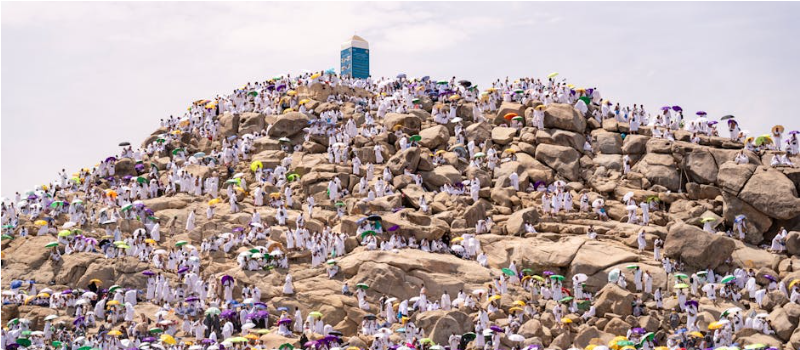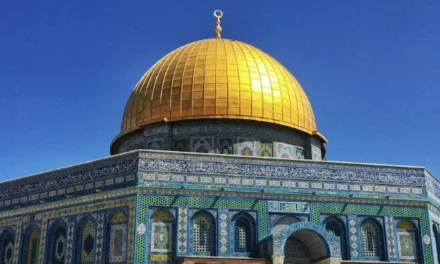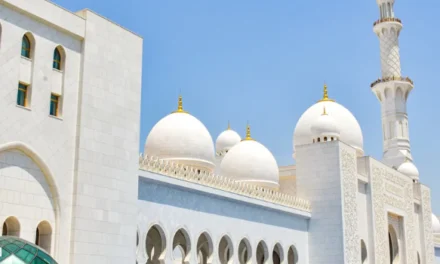The Jinn Mosque, also known as the Masjid al-Jinn or the Mosque of the Jinn, is a captivating and enigmatic Islamic site located in the holy city of Makkah, Saudi Arabia. This mosque holds a unique place in Islamic history and folklore, drawing the attention of believers and researchers alike.
What is the Jinn Mosque?
The Jinn Mosque is a mosque with a fascinating backstory. According to Islamic tradition, it was the place where a group of Jinn (supernatural creatures in Islamic belief) embraced Islam after hearing the Quran being recited by Prophet Muhammad (peace be upon him). This event is documented in the Quran in Surah Al-Jinn, where it is mentioned that a group of Jinn listened to the recitation of the Quran and embraced the faith.
History and Origins of the Jinn Mosque
The origins of the Jinn Mosque can be traced back to the time of Prophet Muhammad (peace be upon him). It is believed that the prophet was in Makkah when a group of Jinn from Yemen came to listen to his recitation of the Quran. The Jinn were so captivated by the words of the Quran that they embraced Islam on the spot. This event is said to have occurred in the area where the Masjid al-Jinn now stands.
Over the centuries, the mosque has undergone various renovations and expansions. It is considered one of the oldest mosques in Makkah, with some sources indicating that it was originally built in the 1700s. The mosque has a special significance for Muslims, as it is associated with the extraordinary event of the Jinn’s conversion to Islam.
Location and Significance of the Jinn Mosque
The Jinn Mosque is located in the Ma’la district of Makkah, just a short distance from the Masjid al-Haram, the holiest site in Islam. The mosque is situated in a spot where the Prophet Muhammad (peace be upon him) is said to have met and interacted with the group of Jinn who later embraced Islam.
The Jinn Mosque holds immense spiritual and cultural significance for Muslims. It is seen as a place where the supernatural and the divine intersect, a testament to the power of the Quran and the message of Islam. Pilgrims and visitors often make the journey to the mosque to pay their respects and connect with the history and legends associated with this remarkable site.
Exploring the Jinn Mosque
Architecture and Design of the Jinn Mosque
The Jinn Mosque is a relatively small and unassuming structure, but its architectural features and design elements hold deep symbolic meaning. The mosque is built with a simple, rectangular layout, featuring a wide praying area and a single minaret. The interior is adorned with intricate calligraphic inscriptions and traditional Islamic motifs, creating an atmosphere of serenity and reverence.
One unique aspect of the Jinn Mosque is the presence of an underground section, which is believed to be the original site where the Jinn gathered to listen to the Quran. This subterranean space is considered sacred and is only accessible to a select few, adding to the mystique and exclusivity of the site.
Legends and Folklore Surrounding the Jinn Mosque
The Jinn Mosque is steeped in legends and folklore that have captivated the imaginations of believers and non-believers alike. The most well-known story is the account of the Jinn’s conversion to Islam, as recorded in the Quran. According to the Islamic tradition, a group of Jinn, upon hearing the recitation of the Quran by Prophet Muhammad (peace be upon him), were moved to embrace the faith.
Other legends surrounding the Jinn Mosque include reports of unexplained phenomena, such as strange noises, apparitions, and even the appearance of Jinn themselves. These tales have contributed to the mosque’s reputation as a place of mystery and the supernatural, drawing visitors who seek to unravel the secrets of this enigmatic site.
Visiting the Jinn Mosque
How to Reach the Jinn Mosque
The Jinn Mosque is located in the Ma’la district of Makkah, a short distance from the Masjid al-Haram, the holiest site in Islam. The mosque can be easily accessed by pilgrims and visitors during their Hajj and Umrah pilgrimages to Makkah.
Best Times to Visit the Jinn Mosque
The best times to visit the Jinn Mosque are during the Hajj and Umrah seasons, when the holy sites in Makkah are bustling with worshippers and pilgrims. This is the time when the mosque is most active, with increased visitation and religious activities. However, the mosque is open year-round, and visitors are welcome to visit and explore the site at their convenience.
Etiquette and Guidelines for Visitors
As with any sacred Islamic site, visitors to the Jinn Mosque are expected to observe certain etiquette and guidelines. These include:
- Dressing modestly and appropriately (covering the head, arms, and legs for both men and women)
- Removing shoes before entering the mosque
- Maintaining a respectful and reverent demeanor
- Refraining from any disruptive or inappropriate behavior
- Seeking permission before entering any restricted or off-limits areas
By following these guidelines, visitors can ensure that their experience at the Jinn Mosque is meaningful, respectful, and in keeping with the sanctity of the site.
The Jinn Connection
Who are the Jinn?
In Islamic belief, the Jinn are a class of supernatural creatures created by God from fire, alongside humans (who were created from clay) and angels (who were created from light). The Jinn are believed to exist in a parallel realm to that of humans and are capable of interacting with the physical world.
The Jinn are mentioned numerous times in the Quran and Islamic tradition, and they are said to possess free will, just like humans. Some Jinn are believed to be righteous and follow the teachings of Islam, while others are considered to be mischievous or even malevolent.
Jinn in Islamic Beliefs and Traditions
The Jinn play a significant role in Islamic beliefs and traditions. They are seen as sentient beings with the ability to impact the lives of humans, both positively and negatively. The Quran and Islamic scholars have provided guidance on how to interact with Jinn, including the recitation of specific verses and the use of protective amulets.
The story of the Jinn’s conversion to Islam, as told in Surah Al-Jinn, is a testament to the power of the Quran and the universality of the message of Islam. This event is deeply revered by Muslims and is a central aspect of the significance of the Jinn Mosque.
Unraveling the Mysteries
Unexplained Phenomena and Paranormal Activity
The Jinn Mosque has long been associated with various unexplained phenomena and paranormal activity. Reports of strange noises, ghostly apparitions, and even encounters with Jinn themselves have contributed to the site’s mystique and reputation for the supernatural.
These reports have fueled speculation and theories about the nature of the Jinn and their connection to the mosque. While some of these claims may be rooted in folklore and superstition, the enigmatic nature of the Jinn Mosque continues to captivate researchers and enthusiasts alike.
Theories and Speculations About the Jinn Mosque
The Jinn Mosque has been the subject of numerous theories and speculations over the years. Some of the most prominent include:
-
The Original Site of the Jinn’s Conversion: Many believe that the mosque’s underground section is the exact spot where the Jinn gathered to listen to the Quran and embraced Islam.
-
The Mosque of the Guards: Some scholars suggest that the mosque was originally known as the “Mosque of the Guards,” as it was built to protect the holy sites of Makkah from any supernatural threats.
-
The Mosque of Allegiance: There are also theories that the Jinn Mosque was the site where the Jinn pledged their allegiance to Islam and the Prophet Muhammad (peace be upon him).
-
Nexus of the Supernatural: The Jinn Mosque is sometimes viewed as a place where the spiritual and physical realms intersect, making it a hub for paranormal activity and Jinn-related phenomena.
These theories and speculations continue to fuel the ongoing fascination with the Jinn Mosque and its place in Islamic history and folklore.
The Cultural and Spiritual Significance
Importance in Local and Regional Culture
The Jinn Mosque holds immense cultural and spiritual significance for the people of Makkah and the broader Islamic world. It is seen as a sacred site that bears witness to the power of the Quran and the universality of the message of Islam.
The mosque is revered as a place of pilgrimage and spiritual connection, drawing devotees and curious visitors from around the globe. It is often included in the itinerary of Hajj and Umrah pilgrimages, as believers seek to connect with the history and legends associated with this unique site.
Spiritual and Religious Significance
The Jinn Mosque is imbued with deep spiritual and religious significance for Muslims. It is believed to be a place where the divine and the supernatural intersect, a testament to the mysteries and wonders of the Islamic faith.
The mosque’s association with the Jinn’s conversion to Islam is especially revered, as it represents the power of the Quran to touch the hearts and minds of all beings, whether human or supernatural. This event is seen as a profound affirmation of the universality and transformative power of the Islamic message.
Preserving the Jinn Mosque
Conservation Efforts and Challenges
The Jinn Mosque, like many historical sites in Makkah, faces ongoing challenges when it comes to preservation and conservation. The rapid development and urbanization of the holy city, coupled with the influx of pilgrims and visitors, has put a strain on the maintenance and upkeep of this ancient site.
Efforts are underway to ensure the Jinn Mosque’s architectural and historical integrity are maintained, with the Saudi government and Islamic authorities working to protect and restore the mosque. However, the task is a delicate one, as any changes or renovations must be done in a way that respects the site’s cultural and religious significance.
Importance of Protecting Historical Sites
The preservation of historical and cultural sites like the Jinn Mosque is of paramount importance, not only for the Muslim community but for the entire world. These sites represent the rich tapestry of human civilization and the diverse spiritual and cultural traditions that have shaped our shared history.
By protecting and maintaining the Jinn Mosque, we not only honor the legacy of Islam but also safeguard the stories, beliefs, and traditions that have been passed down through generations. This ensures that the mysteries and wonders of the Jinn Mosque can continue to captivate and inspire people for years to come.
FAQs:Jinn Mosque
What is the significance of Masjid Al-Jinn in Makkah?
Masjid Al-Jinn, also known as the mosque of guards, holds historical importance as it is believed to be the place where a large group of jinns gathered and listened to the recitation of the Quran by Prophet Muhammad (pbuh) during his time in Makkah.
When was Masjid Al-Jinn originally built?
The structure of Masjid Al-Jinn was originally built in the year 1700, making it one of the important mosques in the region.
What is the connection between Masjid Al-Jinn and Surah Al-Jinn?
Surah Al-Jinn is a chapter in the Quran that discusses the existence and nature of jinns. The mosque is associated with this surah due to the event where the jinns listened to the recitation of the Quran by Prophet Muhammad (pbuh).
Can jinns pray inside Masjid Al-Jinn?
Yes, it is believed that jinns pray inside Masjid Al-Jinn, making it a unique place where both humans and jinns can worship.
Where is Masjid Al-Jinn located in relation to the Haram?
Masjid Al-Jinn is located near the Haram in Makkah, making it accessible for those visiting the sacred mosque.
How large is the praying area in Masjid Al-Jinn?
Masjid Al-Jinn features a wide praying area, accommodating a significant number of worshippers simultaneously.
What is the story behind the jinn coming from Yemen?
According to historical accounts, a large group of jinns from Yemen came to listen to the recitation of the Quran by Prophet Muhammad (pbuh), marking an important event in the history of the mosque.
What are the architectural features of Masjid Al-Jinn?
The structure of Masjid Al-Jinn includes notable features such as a minaret and an underground mosque area, reflecting its unique architectural design.
Is it common to visit Masjid Al-Jinn during Hajj or Umrah?
Yes, many pilgrims visit Masjid Al-Jinn during their pilgrimage to Makkah as it is an important mosque with historical significance related to the Prophet Muhammad’s (pbuh) interactions with the jinns.
Conclusion: Embracing the Enigma of the Jinn Mosque
The Jinn Mosque stands as a testament to the enduring mysteries and wonders of the Islamic faith. This captivating site, with its rich history, legendary associations, and spiritual significance, continues to captivate believers and non-believers alike. As we unravel the layers of myth and legend surrounding the Jinn Mosque, we are reminded of the profound interconnectedness of the physical and the supernatural, and the power of the Quran to touch the hearts and minds of all beings.
Whether you are a devout Muslim seeking to deepen your connection with the sacred, or a curious explorer drawn to the enigmatic nature of this remarkable site, the Jinn Mosque offers a profound and unforgettable experience. By embracing the mystery and wonder of this unique Islamic landmark, we can gain a deeper appreciation for the complexities and marvels of the faith that have shaped the lives of millions around the world.





